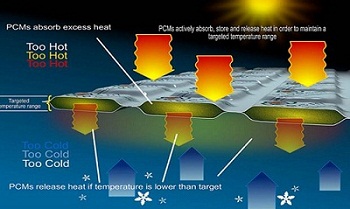Advanced Phase Change Materials Industry
Phase change materials (PCMs) are used for thermal energy storage, enabling the temporary storage of low- or high-temperature energy for later use. Offering a range of thermal management solutions, PCMs facilitate the ability to manage demand between energy requirements and usage. These materials store and release thermal energy on transitioning from one phase to another, that is, when materials freeze, large amount of energy is released as latent heat fusion or energy of crystallisation. Conversely, energy is absorbed from the environment as solids melt into liquid.
For more information see: Phase change materials.
Phase change materials are used for storing latent heat during the phase transition enabling the temporary storage of low or high-temperature energy for later use. This latent heat transition can be achieved with solid-solid, solid-liquid, solid-gas, and liquid-gas phase change. However, at the commercial level, only solid-liquid phase change is used in advanced PCMs since other methods require a large volume and high pressure.
One of the key drivers associated with the growth of advanced phase change materials market is the construction and building sector. Other factors such as increasing awareness of energy conservation, technological advancements in the applications of advanced phase change materials in the textile sector and urbanisation in developing countries are further boosting market growth. However, the high cost associated with advanced phase change materials may hold back the market growth globally.
The Global Advanced Phase Change Materials Market is expected to witness high growth to 2027.
The Global Advanced Phase Change Materials market is segmented by type, application and region:
- With respect to the type, the market is segmented as Organic PCM, Inorganic PCM, and Bio-based PCM.
- On the basis of application, the materials market is segmented into Building & Construction, Energy Storage, HVAC, Shipping & Transportation, Electronics, Textiles, and others.
- By region it is segmented into North America, Europe, APAC, MEA, and South America.
The main players in the market are.
- Advansa B.V.
- BASF SE
- Cryopak
- E. I. Du Pont De Nemours And Company
- Entropy Solutions
- Microtek Laboratories, Inc.
- Outlast Technologies LLC
- Phase Change Energy Solutions
- Pluss Advanced Technologies Pvt. Ltd.
- Sonoco Products Company
Related articles on Designing Buildings Wiki
- Advanced phase change materials.
- Aerogel.
- Assessing the performance of Phase Change Materials in buildings.
- Cool roofs.
- Dynamic thermal modelling of closed loop geothermal heat pump systems.
- Evaporative cooling.
- Heat transfer.
- Latent heat.
- Phase change.
- Phase change materials.
- The thermal behaviour of spaces enclosed by fabric membranes.
- Thermal comfort.
- Thermal labyrinths.
- Transparent insulation materials.
Featured articles and news
RTPI leader to become new CIOB Chief Executive Officer
Dr Victoria Hills MRTPI, FICE to take over after Caroline Gumble’s departure.
Social and affordable housing, a long term plan for delivery
The “Delivering a Decade of Renewal for Social and Affordable Housing” strategy sets out future path.
A change to adoptive architecture
Effects of global weather warming on architectural detailing, material choice and human interaction.
The proposed publicly owned and backed subsidiary of Homes England, to facilitate new homes.
How big is the problem and what can we do to mitigate the effects?
Overheating guidance and tools for building designers
A number of cool guides to help with the heat.
The UK's Modern Industrial Strategy: A 10 year plan
Previous consultation criticism, current key elements and general support with some persisting reservations.
Building Safety Regulator reforms
New roles, new staff and a new fast track service pave the way for a single construction regulator.
Architectural Technologist CPDs and Communications
CIAT CPD… and how you can do it!
Cooling centres and cool spaces
Managing extreme heat in cities by directing the public to places for heat stress relief and water sources.
Winter gardens: A brief history and warm variations
Extending the season with glass in different forms and terms.
Restoring Great Yarmouth's Winter Gardens
Transforming one of the least sustainable constructions imaginable.
Construction Skills Mission Board launch sector drive
Newly formed government and industry collaboration set strategy for recruiting an additional 100,000 construction workers a year.
New Architects Code comes into effect in September 2025
ARB Architects Code of Conduct and Practice available with ongoing consultation regarding guidance.
Welsh Skills Body (Medr) launches ambitious plan
The new skills body brings together funding and regulation of tertiary education and research for the devolved nation.
Paul Gandy FCIOB announced as next CIOB President
Former Tilbury Douglas CEO takes helm.
UK Infrastructure: A 10 Year Strategy. In brief with reactions
With the National Infrastructure and Service Transformation Authority (NISTA).























